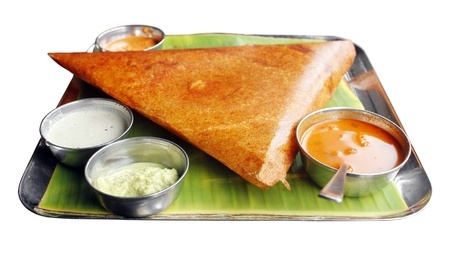
When I talk about breakfast with my associates in India, I wouldn’t necessarily be thinking that the Dosa was top of the list. However, like toast is to the UK breakfast table, so the dosa or dhosa as we might call it is the staple of the Indian breakfast table. It is very much a southern Indian dish. I believe from many reports by colleagues in southern India that it is their favourite breakfast product especially in the metropolitan cities.
The dosa is a traditional fermented pancake made from rice and black gram. It was first written about in Tamil Sangam writings from India in the 6th Century AD. A related product is dhokla which is a fermented mix of wheat and Bengal gram. The dosa originated in western India and was first discussed in 1066 AD which is at the same time as the Norman invasion of England, so it has some pedigree.
If you visit the great cities of Delhi, Mumbai, Chennai, Bengaluru and Pune, you will find the dosa is one of the top 3 most ordered breakfast dishes in these studies. That was based on a survey by the food ordering app. Swiggy which based their evidence on breakfast ordering patterns from 12,000 restaurants in eight Indian cities. This study also found that most Indian households still prefer traditional Indian breakfasts based on poha and parathas instead of their global counterparts but the dosa has the subcontinent’s heart. The dosa is traditionally served with sambhar and chutney.
Preparation Of the Dosa
Preparation time: 20 minutes; Cooking time: 20 minutes; Serving: 8
Soaking time: At least 2 hours; Fermenting time: At least 4 hours
Ingredients:
- 1 cup raw rice
- 1/3 cup of split black gram (urad dal)
- 2 tbsp cooked rice
- 2 tbsp beaten rice (poha)
- 5 to 7 fenugreek (methi) seeds
- salt to taste
- oil for cooking
Preparation
A mixture of raw rice and black gram is first soaked in water. This mix is ground to a fine powder, with water added to form a batter. Some people add a handful of fenugreek seeds soaked along with the rice. The proportion of rice to lentils is generally 4:1 or 5:1. The batter is allowed to ferment overnight. After the overnight fermentation, the batter is mixed with water to obtain the desired thickness.
The batter is then ladled onto a hot tava (griddle) greased with oil or ghee (clarified butter). It is spread out evenly with the base of a ladle or bowl to form a pancake. The dosa is served hot, either folded in half or rolled like a wrap. It is also usually served with chutney and sambar. The mixture of black gram and rice can be replaced with highly refined wheat flour, pearl millet or semolina.
Yum. I love the vegetarian fillings that go into dosas. Have you tried spicy potato or vegan masala which is lovely with proper chutney.
I never used to go for these types of Indian dishes but my hubbie Dev, won’t touch anything else for breakfast. I also know they are reasonably low in saturated fat rather than the heart busting stuff like ghee which Indian chefs prefer to use.
The best bit about a dosa is the Sambar, rasam with a great chutney. I always feel that down in the south of India you get the best breakfasts in the world. There are so many dishes to choose from and I feel the nutritional side is so overlooked. It is the flour that is so special. In the US you cannot get the particular types I need for any of these baked goods. Got to be my favorite of all time. I think you need to check out some great youtube videos on making them too. I thought this version was pretty good though and your idli recipe is one of the best I have found so far.